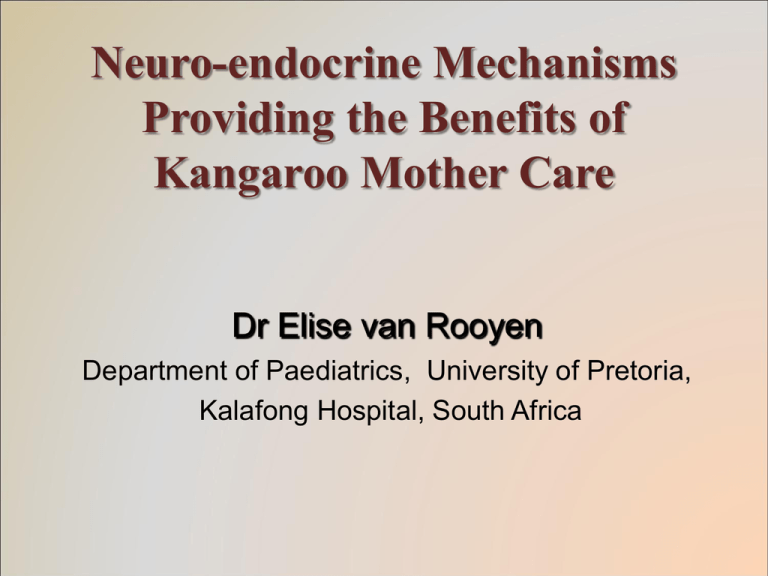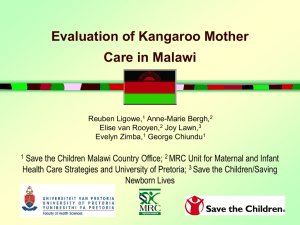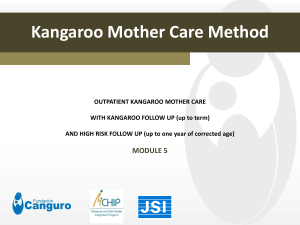Resource - Healthy Newborn Network
advertisement

Neuro-endocrine Mechanisms Providing the Benefits of Kangaroo Mother Care Dr Elise van Rooyen Department of Paediatrics, University of Pretoria, Kalafong Hospital, South Africa Neuro-endocrine Mechanism Many benefits of KMC are related to oxytocin secretion which is released by touch, light pressure and warmth experienced by the infants in the skin-toskin position and during breastfeeding KMC: Effect on Body Temperature KMC maintains adequate temperature for preterm and/or LBW infants Infant body temperature rises in KMC Fewer episodes of hypo- and hyperthermia occurs during KMC It is safe to take care of infants as small as 700g in warm environment with cap Mothers are able to maintain their baby’s temperature within a very narrow temperature range which is not the case in incubator care WHO KMC practical guide, PEP unit 43 Principles of KMC Rewarming Infants with Hypothermia KMC vs Incubator Care Teaching hospital, Lusaka, Zambia 80 babies with temp<36ºC (low risk hypothermia) 41 treated with skin-to-skin contact (SSC) 39 treated in incubator Reaching 36.5ºC at 2 hours 3 hours 4 hours SSC 30% 70% 90% Incubator 21% 39% 60% Adapted from Lancet 1998:352;1115 Role of Oxytocin in Temperature Regulation Circulation in the skin overlying the breast is increased during suckling resulting in increased skin temperature this makes suckling more pleasant for pups Kerstin Uvnäs-Moberg TEM 1996 Circulating oxytocin and neurological triggered vasoactive peptides mediates this cutaneous vasodilation Eriksson et al 1996a&b Temperature of breasts and chest increases not only during breastfeeding but also when milk ejection is triggered psychologically Lind et al. 1971 KMC: Thermal Synchrony A thermal synchrony develops between mom and baby The mother’s core temperature may rise 2ºC or drop one degree in a short period of time, in order to maintain this narrow range Thermal Synchrony in Twins Mother’s breasts have the ability to thermally accommodate multiple infants simultaneously Each breast acts independently to keep a twin warm Case studies by S Ludington KMC: Behavioural Effects - Crying Infants cry for a variety of reasons: Separation from mother, hunger, and in response to pain There was a reduction in crying during KMC compared to incubator care (Cochrane meta-analysis) KMC reduces crying in response to pain (Weller & Feldman) (Ludington-Hoe et al. AACN Clin Issues 2005; 16(3): 373–387) No crying at all when transporting sick infants in KMC position to a distant NICU (Sontheimer et al) Research on Crying Compared babies in KMC with babies in cots Number of crying babies at observation periods performed every 15 minutes for the first 90 minutes after birth There was a significant absence or reduction in crying in infants receiving KMC compared to infants in cots Christensson et al. Acta Paediatr 81:488-93. 1992 KMC: Effect on Neurophysiologic Outcomes Sleep organisation Brain maturation Brain complexity Sleep organisation: Sleep Phases NREM (Quiet Sleep) Stage 1 Stage 2 Stage 3 Stage 4 Drowsy Light – onset of slow wave sleep Deep slow sleep Deep slow wave sleep Crucial for creation of long term memories & learning REM (Active Sleep, Dream Sleep) Paradoxical sleep – rapid eyelid & muscle movements Heart rate & Resp rate Critical component associated with the development of the sensory systems Sleep and Sleep Cycles Sleep and sleep cycles are essential for: Sensory system development in the fetus and young infant Creation of long-term memory and learning Preservation of brain plasticity Sleep deprivation in foetus and neonate has profound effects on early sensory development and creation of permanent neural circuits for the primary sensory systems Sleep Continue Sleeping is not a passive process Sleep is driven by cholinergic cells which stimulate sleep actively – (can be inhibited by depressant drugs) Each specific EEG wave that occur during REM sleep plays a specific role in sensory system development (smell, taste, visual, auditory, touch, motion, position, emotion, or memory) REM sleep deprivation between 30 wks GA and 4-5 mnths results in delayed or disordered development of any or all of the systems above Sleep Pattern in NICU In the NICU, infants demonstrate a very chaotic version of this cycling pattern Incubator Infants only have 10-20 seconds of quiet sleep. (HR and RR also does not change) Disrupted sleep due to separation from mother and care giving environment KMC: Effect on Sleep Organization Increases quantity of Quiet Sleep Non-chaotic sleep pattern Normal sleep cycling Less sleep arousals HR and RR variation according to sleep cycles Preterm sleep cycles generally require 60 minutes to complete and within 5 minutes of the onset of KMC, cycling begins Cycling is needed for Normal Growth Formation of Neuronal Synapses and Growth Sleep Cycling • Preemies in incubators demonstrate non-cycled sleep patterns throughout hospitalization • Result of delay in sleep cycling affect post-discharge sleep for up to 2 yrs (Scher, 1997) Brain Maturity by Complexity Preterm infants who received KMC from 32-40 weeks PMA had better brain maturation in all measures of complexity Brain maturation was better compared to preemies who did not receive KMC Brain maturation was even better compared to full term infants Kaffashi, Scher, Ludington-Hoe et al. Complexity analysis of neonatal EEG. J Electroencephalography Oxytocin’s Analgesic Effects Oxytocin administered in mice has an analgesic effect in response to (formalin-induced) pain Oxytocin acts on the κ- & δ-opioid receptors in the brain Chronic (X 7 days) administration of oxytocin did not K Reeta, et al. Regulatory Peptides 2006;135:85–90 produce tolerance KMC: Effect on painful procedures • Preterm infants exhibit less audible and inaudible (facial grimacing, eye squeezing and brow bulging) crying during and after heel pricks when in KMC compared to incubator R Kostandy, et al. 2008;9(2) • KMC reduces crying associated with painful procedures (Weller & Feldman): KMC: Effects on Nosocomial Infections Infants who received 24/7 KMC had infections by discharge (3 randomized trials) Infections in infants who received KMC (Cochrane meta-analysis) Nosocomial infections may be due to Enhanced stratum corneum barrier function when hydration increases and trans-epidermal water loss decreases Improved immunity Oxytocin Less stress Breastmilk KMC reduces Mortality? A meta-analysis shows that KMC reduces neonatal mortality amongst preterm babies (birth weight <2000 g) in hospital, and is highly effective in reducing severe morbidity, particularly from infection Joy Lawn et al. International Journal of Epidemiology 2010;39:i144–i154 Cochrane meta-analysis KMC Effect on Desaturation Events During KMC the number of desaturation events decreased in breastfed infants Relationship between desaturation events and method of feeds 20 desaturation events occured after bottle feeding during KMC None occured during breastfeeding (Chen) Oxytocin Effects on Growth Suckling, massage and warm temperature influence the release of GI hormones (Uvnas-Moberg et al. 1992) Oxytocin stimulates digestion, weight gain and growth by activation of the endocrine system of the GIT One study showed that oxytocin injections caused increased weight gain in mice Kerstin Uvnas-Moberg.: Massage, Relaxation & Well-being: A possible role for Oxytocin E Bjorkstrand, K. Uvnas-Moberg. Physiol Behav. 1996;59(4/5):947-952 Effects on Growth Another study showed that increased levels of oxytocin after massage coincided with a rise of GI hormones in the blood A third study suggested that the weight gain observed in preterm infants who received massage therapy was related to an increase in vagal tone Kerstin Uvnas-Moberg. E Bjorkstrand, K. Uvnas-Moberg.. Physiol Behav. 1996;59(4/5):947-952 Weight gain associated with Massage & Oxytocin release Increased weight gain was not associated with increased food consumption This suggests that the treatments had induced a higher metabolic efficiency and that energy was used for anabolic metabolism S Holst, et al. Autonomic Neuroscience: Basic and Clinical 2005;120:73 – 79 Oxytocin: Cardiovascular Effects Lower blood pressure Lower pulse rate CARDIOVASCULAR “PROTECTIVE EFFECT” LC Michelini, MC Marcelo, J Amico, M Morris.. American Journal of Physiology - Heart & Circulatory Physiology. 2003;284(6):2269-76. Kerstin Uvnas-moberg. Acta Physiologica Scandinavica Supplementum.1997;640:38-42 KMC: Effect on Physiological Stress Cortisol levels has been studied as a sign of physiological stress in preterm infants >60% reduction in cortisol levels in stable preterms receiving KMC (>20 min) KMC reduces stress in preterm infants most likely due to the secretion of oxytocin Mooncey S, Giannakoulopoulos X, Glover V, Acolet D, Modi N, 1997. Infant Behaviour and development 20(4): 553-557. Role of Oxytocin in: Pro-social Behaviour And Disorders due to Aberrant Social Interactions Oxytocin Mediates Pro-social Behaviour Oxytocin receptors are distributed in various brain regions responsible for the formation of normal social attachments and affiliation Oxytocin promotes bonding (maternal, paternal & pairing) the subjective experience of attachment security trusting & trustworthy behaviour (NOT risk taking behaviour) ability to infer mental state of others from facial cues Oxytocin suppresses fear-related activation of amygdala in healthy individuals in social situations M Heinrichs et al. Frontiers in Neuroendocrinology 30 (2009) 548-557 KMC Effects on Early Mother-Infant Relationship Findings from a Canadian Sample of Full-Term Infants Newborn infants use much of their energy making physiological adjustments to postnatal life Many of their physiological states – crying & sleeping does not allow for taking in information from the external world The one exception is the quiet alert state Early skin-to-skin contact increases the infants’ ability to regulate their state organization KMC facilitates infants’ ability to move into and maintain the quiet alert state Researcher: Ann Bigelow, Antigonish, Nova Scotia KMC Effects on Early MotherInfant Relationship Cont. The quiet alert state allow infants to be aware of external stimulation from the mother It allows them to participate more actively in interactions with their mothers Facilitates the infants’ own growth and development Also fosters early social relations KMC influence mothers to enhance their maternal behaviours Mothers demonstrate more sensitivity to their infants’ signals and to their early social behaviour Prevent Separation If possible – no baby should be separated from their mother If there is separation – introduce skin-to-skin care as soon as possible and as often as possible Commence continuous KMC as soon as infant is stable Keep Mothers & Babies together! Literature Susan M. Ludington-Hoe, Kathy Morgan, Amel Abouelfettoh, A Clinical Guideline for Implementation of Kangaroo Care With Premature Infants of 30 or More Weeks’ Postmenstrual Age. Advances in Neonatal Care 2008 Vol. 8, No. 3S Evidence-based clinical practice guidelines for an optimal use of the kangaroo mother method in preterm and/or low birthweight infants at birth. Fundación Canguro and Department of Clinical Epidemiology and Biostatistics, School of Medicine – Pontificia, Universidad Javeriana, Bogotá, 2005 – 2007, Juan Gabriel Ruiz P, Nathalie Charpak World Health Organization. Kangaroo mother care: a practical guide. Geneva: World Health Organization, Department of Reproductive Health and Research; 2003 Kerstin Uvnas-moberg. Oxytocin Linked Antistress Effects – The Relaxation And Growth Response. Acta Physiologica Scandinavica Supplementum.1997;640:38-42 K Uvnas-moberg. Oxytocin – A Possible Mediator Of Anti-stress Effects Induced By Acupuncture. Journal Of Acupuncture In Medicine. 2002;20:109-110 M Hernandez-Reif, M Diego, T Field. Preterm Infants Show Reduced Stress Behaviors And Activity After 5 Days Of Massage Therapy. Infant Behavior & Development. 2007;30: 557–561 References Kerstin Uvnas-Moberg. Touch - Chapter 12: Massage, Relaxation And Well-being: A Possible Role For Oxytocin E Bjorkstrand, K. Uvnas-Moberg. Central oxytocin increases food intake and daily weight gain in rats. Physiol Behav. 1996;59(4/5):947-952 S Holst, I Lund, M Petersson, K Uvna¨s-Moberg. Massage-like stroking influences plasma levels of gastrointestinal hormones, including insulin, and increases weight gain in male rats. Autonomic Neuroscience: Basic and Clinical 2005;120:73 – 79 R Kostandy, et al. Pain Management Nursing. Kangaroo care (skin contact) reduces crying response to pain in preterm neonates: pilot results. 2008;9(2): LC Michelini, MC Marcelo, J Amico, M Morris. Oxytocinergic regulation of cardiovascular function: studies in oxytocin-deficient mice. American Journal of Physiology - Heart & Circulatory Physiology. 2003;284(6):2269-76. R Kostandy, et al. Pain Management Nursing. Kangaroo care (skin contact) reduces crying response to pain in preterm neonates: pilot results. 2008;9(2): K Reeta, et al. Role of κ- and δ-opioid receptors in the antinociceptive effect of oxytocin in formalin-induced pain response in mice. Regulatory Peptides 2006;135:85– 90 References cont. S HolstT, I Lund, M Petersson, K Uvna¨s-Moberg. Massage-like stroking influences plasma levels of gastrointestinal hormones, including insulin, and increases weight gain in male rats. Autonomic Neuroscience: Basic and Clinical 2005;120:73 – 79 Trends Endicrinol Metab 1996;7:126-131 M Heinrichs, B von Dawans, G Domes. Oxytocin, vasopressin, and human social behavior. Frontiers in Neuroendocrinology 30 (2009) 548-557 Brain Research. 2005;1049:234 – 239 Review of medical physiology. 20th ed. Publisher: Lang Medical Books. W Ganong M Peterssona. Oxytocin increases the density of high affinity a2-adrenoceptors within the hypothalamus, the amygdala and the nucleus of the solitary tract in ovariectomized rats. Brain Research. 2005;1049:234 – 239 E Bjorkstrand, K. Uvnas-Moberg. Central oxytocin increases food intake and daily weight gain in rats. Physiol Behav. 1996;59(4/5) :947-952 Juan Gabriel Ruiz P, Nathalie Charpak. Evidence-based clinical practice guidelines for an optimal use of the kangaroo mother method in preterm and/or low birthweight infants at birth. Fundación Canguro and Department of Clinical Epidemiology and Biostatistics, School of Medicine – Pontificia, Universidad Javeriana, Bogotá, 2005 – 2007, References cont. World Health Organization. Kangaroo mother care: a practical guide. Geneva: World Health Organization, Department of Reproductive Health and Research; 2003 Ludington-Hoe SM, Johnson MW, Morgan K, Lewis T, Gutman J, Wilson D, Scher MS. Neurophysiologic assessment of neonatal sleep organization: Preliminary results of a randomized controlled trial of skin contact with preterm infants. Pediatrics 2006;117(5) e909-e923. Woods DL, Principles of Kangaroo Mother Care unit 43 in Woods DL (ed) Mother and baby friendly care, Cape Town: Perinatal education programme 2005 World Health Organization. Kangaroo mother care: a practical guide. Geneva: World Health Organization, Department of Reproductive Health and Research; 2003 Mirmiran & Ariagno Role of REM sleep in brain development and plasticity) Graven SN, Browne JV. 2008:Volume 8(4), www.nainr.com Scher MS, Ludington-Hoe S, et al Clinical Neurophysiology 120 (2009) 1812-1818 Development of fetal and neonatal sleep and circadian rhythms* M Mirmiran, YG.H. Maas, RL. Ariagno Sleep Medicine Reviews, Vol. 7, No. 4, p. 321±334, 2003 References cont. Stanley N. Graven, J V. Browne, Sleep and Brain Development: The Critical Role of Sleep in Fetal and Early Neonatal Brain Development. Newborn & Infant Nursing Reviews, December 2008; Vol 8, Number 4: 173-179 Mooncey S, Giannakoulopoulos X, Glover V, Acolet D, Modi N, 1997. The Effect of Mother-Infant Skin-to-Skin Contact on Plasma Cortisol and beta-endorphin Concentrations in Preterm Newborns. Infant Behaviour and development 20(4): 553-557.





